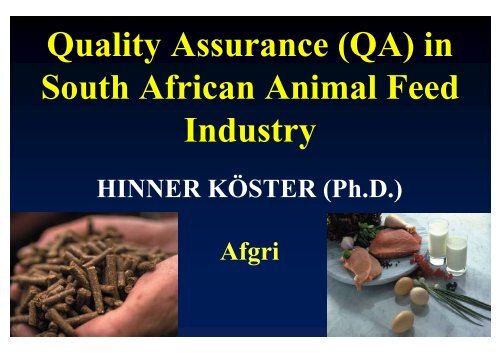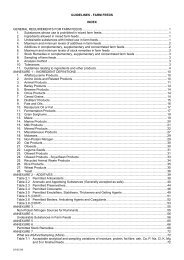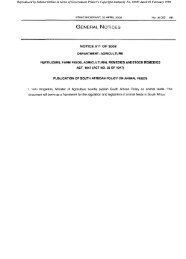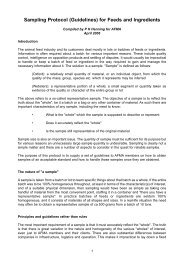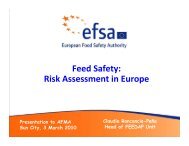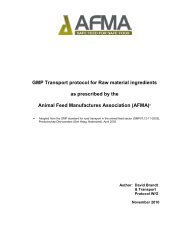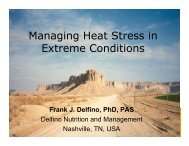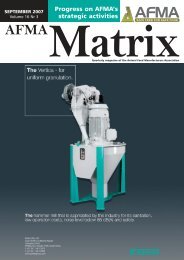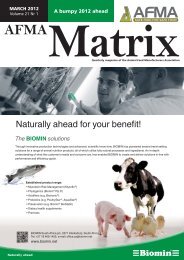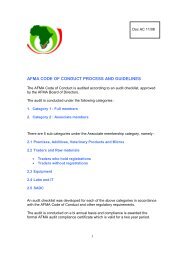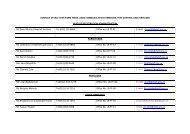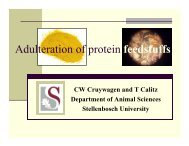Quality Assurance (QA) in South African Animal Feed Industry - AFMA
Quality Assurance (QA) in South African Animal Feed Industry - AFMA
Quality Assurance (QA) in South African Animal Feed Industry - AFMA
Create successful ePaper yourself
Turn your PDF publications into a flip-book with our unique Google optimized e-Paper software.
<strong>Quality</strong> <strong>Assurance</strong> (<strong>QA</strong>) <strong>in</strong><br />
<strong>South</strong> <strong>African</strong> <strong>Animal</strong> <strong>Feed</strong><br />
<strong>Industry</strong><br />
HINNER KÖSTER (Ph.D.)<br />
Afgri
Position of animal feed <strong>in</strong>dustry<br />
<strong>Animal</strong> <strong>Feed</strong><br />
Livestock farm<strong>in</strong>g<br />
Process<strong>in</strong>g <strong>in</strong>dustry<br />
Retail<br />
Consumer
Objective of structured <strong>QA</strong> program for<br />
entire SA feed <strong>in</strong>dustry<br />
• Produce, deliver and feed animal feeds safe to:<br />
• Consumers of animal products<br />
• <strong>Animal</strong>s consum<strong>in</strong>g feed<br />
• Environment<br />
• Produce and supply animal feeds <strong>in</strong> a trustworthy way for<br />
all stakeholders<br />
• Partners <strong>in</strong> cha<strong>in</strong><br />
• Consumers<br />
• Legislators<br />
• Must safeguard products <strong>in</strong> demonstrable and transparent<br />
way via certified quality guarantee system<br />
• Basis for license to produce
Triggers to enhance <strong>QA</strong> program <strong>in</strong><br />
global feed <strong>in</strong>dustry<br />
Initial triggers – <strong>QA</strong> system largely re-active:<br />
•Salmonella <strong>in</strong> eggs and poultry meat (1988)<br />
•High aflatox<strong>in</strong> <strong>in</strong> USA maize gluten feed (1989)<br />
•Residue antibiotics <strong>in</strong> eggs (1988 – 1992)<br />
Triggers for drastic changes – required pro-active approach:<br />
•BSE and meat-and-bone meal (1989, 1997, 2000)<br />
•Diox<strong>in</strong> <strong>in</strong> Brazilian citrus pulp (1998)<br />
•Diox<strong>in</strong> <strong>in</strong> Belgian feed fat (1999)<br />
•Diox<strong>in</strong> <strong>in</strong> German bakery products (2003)
Enhancement <strong>in</strong> global <strong>QA</strong> System<br />
•Shift from re-active to pro-active system<br />
•Involv<strong>in</strong>g risk analysis <strong>in</strong> entire feed production cha<strong>in</strong> by<br />
<strong>in</strong>tegrat<strong>in</strong>g HACCP <strong>in</strong>to GMP standard<br />
•HACCP also applied <strong>in</strong> EU food <strong>in</strong>dustry<br />
•L<strong>in</strong>k feed cha<strong>in</strong> to food cha<strong>in</strong><br />
•Upstream extension of quality assurance<br />
•To all suppliers of feed <strong>in</strong>gredients<br />
•Development of early warn<strong>in</strong>g system<br />
•Report <strong>in</strong>cidental unacceptable contam<strong>in</strong>ation despite all<br />
precautionary and controlled measures<br />
•Tackle problems at an early stage<br />
•Improvement of communication
<strong>Animal</strong> feed cha<strong>in</strong> - part of food cha<strong>in</strong><br />
•<strong>Feed</strong> <strong>Quality</strong><br />
•<strong>Feed</strong> safety as part of food safety is highest priority<br />
•Nutritional, technical and emotional quality of feed also<br />
important for common <strong>in</strong>dustry policy<br />
•Lower priority then feed safety
<strong>Animal</strong> feed cha<strong>in</strong> - part of food cha<strong>in</strong><br />
•Control of product safety non negotiable for ga<strong>in</strong><strong>in</strong>g<br />
and ma<strong>in</strong>ta<strong>in</strong><strong>in</strong>g public confidence <strong>in</strong> food safety and<br />
undisturbed sales of food products<br />
•If food safety cannot be guaranteed:<br />
1.Stagnation of sales<br />
2.Decreased consumer confidence<br />
3.Negative f<strong>in</strong>ancial impact for companies participat<strong>in</strong>g <strong>in</strong><br />
food cha<strong>in</strong><br />
4.Need for safety requirements <strong>in</strong> legislature and retail<br />
trade <strong>in</strong>creases
<strong>South</strong> <strong>African</strong> <strong>QA</strong><br />
Scenario and Progress<br />
Made
<strong>Animal</strong> <strong>Feed</strong> <strong>Industry</strong><br />
DoA<br />
DoH<br />
INTERNATIONAL RELATIONS<br />
•World Trade Organisation (WTO)<br />
•International Trade and Arbitration Commission<br />
(ITAC)<br />
•International <strong>Feed</strong> <strong>Industry</strong> Federation (IFIF)<br />
•<strong>South</strong>ern <strong>African</strong> Development Community (SADC)<br />
•European Free Trade Association (EFTA)<br />
•AfricaBio<br />
Directorate Food Safety and <strong>Quality</strong> <strong>Assurance</strong><br />
Fertilizers, Farm <strong>Feed</strong>s, Agricultural Remedies and Stock Remedies Act, No.<br />
36 of 1947<br />
•Regulations relat<strong>in</strong>g to farm feeds, R.1087, 3 Nov 2006<br />
•Regulations relat<strong>in</strong>g to the Labell<strong>in</strong>g and advertis<strong>in</strong>g of<br />
foodstuffs, R.1055, 8 Aug 2002<br />
•Regulations relat<strong>in</strong>g to maximum levels for metals <strong>in</strong><br />
foodstuffs, No. R.500, 30 Apr 2004<br />
Regulations govern<strong>in</strong>g general hygiene requirements for food<br />
premises and the transport of food, No. R.918, 3 Jul 1999<br />
Directorate of Food Control<br />
The Foodstuffs, Cosmetic and<br />
Dis<strong>in</strong>fectant Act, No. 54 of 1972<br />
National Health Act, No. 61 of<br />
2003<br />
<strong>Animal</strong> <strong>Feed</strong> Manufacturers’<br />
Association (<strong>AFMA</strong>)<br />
Sterilis<strong>in</strong>g<br />
Plant for<br />
animal<br />
products<br />
Guidel<strong>in</strong>es with respect to the Medic<strong>in</strong>e and<br />
Related Substances Act, No. 101 of 1965<br />
Medic<strong>in</strong>es and Related Substances<br />
Control Act, No. 101 of 1965<br />
Directorate: Food Control<br />
•Gra<strong>in</strong> SA<br />
•Chamber of Mill<strong>in</strong>g<br />
•SA Agricultural Processors<br />
Association (SAAPA)<br />
BSE Free <strong>Animal</strong><br />
Products<br />
Veter<strong>in</strong>ary<br />
Import permit<br />
<strong>Animal</strong> Products<br />
Registration of a feed mill as an<br />
approved source of feed to<br />
farms that export meat to the<br />
EU<br />
Import<br />
Imported Products<br />
•Oilseeds<br />
•Oilcake (Sunflower, Soya,<br />
Cotton, Groundnut)<br />
•Fishmeal<br />
•Maize<br />
•Sorghum<br />
<strong>Animal</strong> <strong>Feed</strong><br />
Manufacturers/ <strong>Feed</strong><br />
Mill<br />
Ingredients<br />
•Alfalfa/Lucerne Products<br />
•Am<strong>in</strong>o Acids & Related Products<br />
•<strong>Animal</strong> Products<br />
•Gra<strong>in</strong> products<br />
•Brewers/Distillers/Fermentation Products<br />
•Citrus Products<br />
•Fats and oils<br />
•Maize<br />
•Mar<strong>in</strong>e products (Fish meal)<br />
•Milk products<br />
•M<strong>in</strong>eral products<br />
•Molasses<br />
•Oilseeds<br />
•Oilseed products (Oilcake)<br />
•Recycled animal waste products<br />
•Yeast<br />
Permitted Additives<br />
•Antioxidants<br />
•Preservatives<br />
•Colourants<br />
•B<strong>in</strong>ders<br />
•Anticak<strong>in</strong>g Agents<br />
•Emulsifiers, Stabilisers<br />
Permitted Stock Remedies<br />
EHO<br />
•Growth hormones<br />
•Fungal Tox<strong>in</strong>s<br />
•Salmonella<br />
<strong>Animal</strong> <strong>Feed</strong><br />
Undesirable substances<br />
•Arsenic<br />
•Heavy metals (Lead, Mercury, Cadmium)<br />
•Fluor<strong>in</strong>e<br />
•Nitrites<br />
•Aflatox<strong>in</strong><br />
•Hydrocyanic Acid<br />
•Free Gossypol<br />
•Theobrom<strong>in</strong>e<br />
•Volatile Mustard Oil<br />
•V<strong>in</strong>yl Thiooxazolidone (v<strong>in</strong>yloxazolid<strong>in</strong>e thione)<br />
•Rye ergot<br />
•Poisonous Weed Seeds/ Botanical Impurities<br />
•Pesticide Residues<br />
EXPORT<br />
Approved Laboratories<br />
•Deltamune<br />
•Onderstepoort<br />
Type of <strong>Feed</strong><br />
•Dairy<br />
•Pigs<br />
•Beef & Sheep<br />
•Layers / Layer Breeders / Pullets<br />
•Broilers<br />
•Horses<br />
•Dogs<br />
•Ostriches<br />
•Aquaculture<br />
Trade<br />
metrology<br />
Inspection<br />
Weights &<br />
measures<br />
Exported products<br />
•Fish meal<br />
•Soya bean meal<br />
•Cotton oil cake<br />
•Sunflower oil cake<br />
•Full fat soya<br />
•Meat & bone meal<br />
•Maize (white & yellow)<br />
•Soya beans<br />
•Sunflower seeds<br />
•Oats<br />
dti<br />
NRCS<br />
Legal Metrology<br />
DoH<br />
<strong>Animal</strong> Health Act, No. 7 of 2002<br />
Directorate Veter<strong>in</strong>ary Services<br />
<strong>Animal</strong> Products<br />
APIS <strong>Quality</strong><br />
<strong>in</strong>spection<br />
Veter<strong>in</strong>ary Health<br />
Certificate SA<br />
Phytosanitary<br />
Certificate<br />
Agricultural Products Standards Act, No. 119 of 1990<br />
Directorate Food Safety and <strong>Quality</strong> <strong>Assurance</strong><br />
DoA<br />
DoA
Codes of Practice/Protocols<br />
1. GMP as National Standard for <strong>Animal</strong> <strong>Feed</strong><br />
Production<br />
2. GMP Transport Protocol for Raw Materials<br />
3. Control of Salmonella <strong>in</strong> the Production of<br />
<strong>Animal</strong> <strong>Feed</strong><br />
4. Control of Mycotox<strong>in</strong>s <strong>in</strong> the Production of<br />
<strong>Animal</strong> <strong>Feed</strong><br />
5. BSE Protocol for the use of Mammalian Prote<strong>in</strong>s<br />
<strong>in</strong> <strong>Animal</strong> <strong>Feed</strong>s<br />
6. Sampl<strong>in</strong>g Protocol for <strong>Animal</strong> <strong>Feed</strong>s and<br />
Ingredients<br />
7. Code of Conduct for <strong>AFMA</strong> Members
Good Manufactur<strong>in</strong>g Practice (GMP)<br />
• <strong>Feed</strong> and food scares<br />
• <strong>Quality</strong> must be assured by at least a recognised<br />
basic quality guarantee system<br />
• SA <strong>in</strong>dustry must adhere to global norms and<br />
standards to be <strong>in</strong>ternationally competitive<br />
• Require <strong>in</strong>ternationally accepted GMP Code of<br />
Practice<br />
• Also ensures traceability as m<strong>in</strong>imum requirement by<br />
first world importers
Good Manufactur<strong>in</strong>g Practice (GMP)<br />
•GMP code of Practice for SA feed <strong>in</strong>dustry drawn up<br />
•Covers:<br />
1.Trade and production of compound feed<br />
2.Simple and moisture-rich animal feed<br />
3.<strong>Animal</strong> feed <strong>in</strong>gredients<br />
4.Premixes<br />
•Ensures that:<br />
1.Delivery of products and services of feed products and<br />
providers of services consistently meet requirements laid<br />
down by law with regard to human, animal and<br />
environmental safety
Good Manufactur<strong>in</strong>g Practice (GMP)<br />
•GMP code<br />
•Compatible with latest Codex Alimentarius code<br />
•Based on HACCP approach us<strong>in</strong>g Dutch GMP Code as base document<br />
•Based on risk analysis approach and consists of:<br />
•Risk assessment<br />
•Risk management<br />
•Risk communication<br />
•Part of a submission on Regulations and Guidel<strong>in</strong>es that will be<br />
<strong>in</strong>corporated <strong>in</strong>to new Agricultural Production Enhancement Agents<br />
Act<br />
•Will only be enforced under the new Act<br />
•All feed mills will eventually have to comply to GMP<br />
•Some already comply to <strong>in</strong>ternational ISO and HACCP standards<br />
•Level of compliance will depend on type of feed produced (medication<br />
used) and whether sold or not
Good Manufactur<strong>in</strong>g Practice (GMP)<br />
•GMP code<br />
•Responsible organisations for draft:<br />
•<strong>AFMA</strong>, Government, SABS, Parastatals<br />
•Draft 4 completed mid 2008<br />
•Expected completion date - end of 2008/beg<strong>in</strong>n<strong>in</strong>g of 2009<br />
•Process to follow:<br />
1.Vot<strong>in</strong>g on document (done)<br />
2.Legal and technical adjustments to fit SABS requirements<br />
(<strong>in</strong> process)<br />
3.Publish<strong>in</strong>g on SABS website and sent for public comments<br />
to all standard writ<strong>in</strong>g authorities (<strong>in</strong> process)<br />
4.Becom<strong>in</strong>g legal national SABS standard
Good Manufactur<strong>in</strong>g Practice (GMP)<br />
• GMP code<br />
•Focal po<strong>in</strong>ts<br />
•Generic control measures for production, trade and transport<br />
•Management of veter<strong>in</strong>ary medic<strong>in</strong>es and additives<br />
•Control of undesirable materials<br />
•Ensur<strong>in</strong>g hygiene and safety (microbiological aspects)<br />
•Allow us to deliver products and services that comply<br />
with all quality standard requirements<br />
•Includes standards and conditions laid down <strong>in</strong> animal feed<br />
legislation<br />
•Supplemented with standards agreed with next l<strong>in</strong>k <strong>in</strong><br />
animal production cha<strong>in</strong>
GMP Transport Protocol for Raw Material<br />
<strong>in</strong>gredients<br />
• Approved by Technical Committee <strong>in</strong> 2008 by <strong>AFMA</strong><br />
• Wait for approval by Trade Committee<br />
• Adapted from GMP standard for road transport <strong>in</strong> animal feed<br />
sector, Productschap Diervoeders (The Hague, April 2003)<br />
• Target group<br />
• All road transporters transport<strong>in</strong>g RM for the animal feed manufactur<strong>in</strong>g<br />
<strong>in</strong>dustry<br />
• Either directly or <strong>in</strong>directly to feed manufactur<strong>in</strong>g or storage facilities<br />
• Must register with <strong>AFMA</strong> as a transporter<br />
• Monitor<strong>in</strong>g<br />
• Done by <strong>AFMA</strong> members<br />
• Audits and results forwarded to <strong>AFMA</strong>
What do we miss <br />
Participation <strong>in</strong> Integrated<br />
Cha<strong>in</strong> (<strong>Quality</strong>) Control is<br />
a ‘must’<br />
•Retail driven!<br />
•Attention turns to<br />
controll<strong>in</strong>g various critical<br />
steps <strong>in</strong> overall production<br />
process<br />
•Rather than expensive end<br />
product <strong>in</strong>spections
Codes of Practice/Protocols<br />
1. GMP as National Standard for <strong>Animal</strong> <strong>Feed</strong><br />
Production<br />
2. GMP Transport Protocol for Raw Materials<br />
3. Control of Salmonella <strong>in</strong> the Production of<br />
<strong>Animal</strong> <strong>Feed</strong><br />
4. Control of Mycotox<strong>in</strong>s <strong>in</strong> the Production of<br />
<strong>Animal</strong> <strong>Feed</strong><br />
5. BSE Protocol for the use of Mammalian Prote<strong>in</strong>s<br />
<strong>in</strong> <strong>Animal</strong> <strong>Feed</strong>s<br />
6. Sampl<strong>in</strong>g Protocol for <strong>Animal</strong> <strong>Feed</strong>s and<br />
Ingredients<br />
7. Code of Conduct for <strong>AFMA</strong> Members
Salmonella<br />
• <strong>Animal</strong> feed still major source of <strong>in</strong>fection <strong>in</strong><br />
poultry flocks<br />
• High risk raw materials<br />
• Recontam<strong>in</strong>ation of feed post manufactur<strong>in</strong>g (e.g. poor<br />
hygienic conditions)<br />
• Standards and control measures have been<br />
laid down <strong>in</strong> SA <strong>Animal</strong> <strong>Feed</strong> GMP code<br />
• Aimed at:<br />
• Process<strong>in</strong>g phase dur<strong>in</strong>g feed production<br />
• Supply of salmonella-critical feed materials
Salmonella<br />
• Code of Practice with<strong>in</strong> framework of GMP code<br />
(November 2004)<br />
• Based on similar code accepted by Productschap<br />
Diervoerder <strong>in</strong> The Hague (January 2003)<br />
• Purpose :<br />
• Identify and control high risk raw <strong>in</strong>gredients and critical<br />
control po<strong>in</strong>ts <strong>in</strong> production process<br />
• Ma<strong>in</strong> focal areas for salmonella control:<br />
• Premises, transport, feed <strong>in</strong>gredients, compound feed<br />
• Def<strong>in</strong>e actions if positive sample is found
Salmonella<br />
• Code of Practice with<strong>in</strong> framework of GMP code (November 2004)<br />
• Monitor<strong>in</strong>g program <strong>in</strong> accordance with protocols for each<br />
salmonella-critical feed <strong>in</strong>gredient and f<strong>in</strong>al products<br />
• Includes list of Salmonella critical raw materials, dangerous<br />
salmonella types, SANAS approved test laboratories (detection<br />
and/or serotyp<strong>in</strong>g) and ISO accredited methods (e.g. 6579) for<br />
analysis<br />
• <strong>AFMA</strong> ma<strong>in</strong>ta<strong>in</strong>s database on feed <strong>in</strong>gredients and f<strong>in</strong>al products<br />
• <strong>Feed</strong> mill monitor<strong>in</strong>g to follow<br />
• Seen as an early warn<strong>in</strong>g system to create awareness and protect<br />
humans and animals
Mycotox<strong>in</strong>s<br />
• Unique analytical challenges (detection not exact)<br />
• Representative sampl<strong>in</strong>g – greatest chance for error<br />
• Sample heterogenous<br />
• Analysis at low regulatory limits of control required<br />
• Cost<br />
• Detoxify<strong>in</strong>g feeds on a cont<strong>in</strong>uous basis is also<br />
expensive and <strong>in</strong>effective<br />
• Makes it very difficult for feed companies to take sole<br />
responsibility for mycotox<strong>in</strong> contam<strong>in</strong>ation
Mycotox<strong>in</strong>s<br />
• All local organisations <strong>in</strong> feed-food cha<strong>in</strong> need to<br />
cooperate to successfully address mycotoxycosis<br />
• <strong>AFMA</strong> expressed a need for an early warn<strong>in</strong>g<br />
management system<br />
• Should identify high-risk commodities<br />
• Should identify problems <strong>in</strong> early phases of feed and<br />
food cha<strong>in</strong><br />
• Based on weather patterns, geographical areas,<br />
seasonal changes, storage and handl<strong>in</strong>g
Mycotox<strong>in</strong>s<br />
•<strong>AFMA</strong> <strong>in</strong>itiated development of National Mycotox<strong>in</strong><br />
Information System<br />
•CSIR, SABS, SAGL, Maize Trust, etc. <strong>in</strong>volved <strong>in</strong> projects<br />
•Steer<strong>in</strong>g committee with conveners had 3 rd meet<strong>in</strong>g – 16<br />
April 2008<br />
•Focus areas assigned to conveners:<br />
1.Guidel<strong>in</strong>es for mycotox<strong>in</strong>s <strong>in</strong> feed and food<br />
2.Establishment of Mycomap<br />
3.Establishment of Prediction Model<br />
4.Identification of risk areas where mycotox<strong>in</strong>s occur<br />
5.New areas of research <strong>in</strong> mycotox<strong>in</strong>s
Mycotox<strong>in</strong>s<br />
• Code of Practice - has been drafted (June 2003)<br />
• Purpose:<br />
• Overview on Mycotox<strong>in</strong>s<br />
• Guidel<strong>in</strong>es for establish<strong>in</strong>g Good Practices for the control of<br />
mycotox<strong>in</strong>s <strong>in</strong> the feed <strong>in</strong>dustry<br />
• Interim guidel<strong>in</strong>es on maximum acceptable levels <strong>in</strong> SA feeds<br />
until local and/or <strong>in</strong>ternational accepted regulations are set<br />
• Follow pr<strong>in</strong>ciples proposed by Food & Agriculture<br />
Organisation (FAO, EU)<br />
• Based on large variety of studies on mycotox<strong>in</strong>s published<br />
world-wide
Mycotox<strong>in</strong>s<br />
• Code of Practice<br />
• Sets sampl<strong>in</strong>g and test<strong>in</strong>g procedure<br />
• Based on SA regulations<br />
• Takes guidance from Codex Alimentarius<br />
Commission of the Food & Agriculture Organisation<br />
(FAO, EU) and Food & Drug Adm<strong>in</strong>istration (FDA,<br />
USA)<br />
• Reviewed cont<strong>in</strong>uously by <strong>AFMA</strong>
BSE and the use of animal by-products <strong>in</strong> feeds<br />
• Voluntary ban on use of MBM and BM<br />
implemented s<strong>in</strong>ce 1997 and 1999 respectively<br />
• Ban supported by <strong>Feed</strong>lot Association<br />
• Accord<strong>in</strong>g to GBR (EFSA rat<strong>in</strong>g), <strong>South</strong> Africa is<br />
categorised as level 3 by SSC of the EC<br />
• Likely but not confirmed that domestic cattle are<br />
cl<strong>in</strong>ically or sub cl<strong>in</strong>ically <strong>in</strong>fected with BSE agent<br />
• Need to get to level 1 (BSE-risk free)
BSE and the use of animal by-products <strong>in</strong> feeds<br />
• Follow<strong>in</strong>g EFSA visit <strong>in</strong> 2007, Directorate Veter<strong>in</strong>ary<br />
Services undertook evaluation<br />
– Follow<strong>in</strong>g shortcom<strong>in</strong>gs required by OIE have been identified:<br />
1. MBM regulation not <strong>in</strong> place<br />
2. Lack of traceability system<br />
– What comes <strong>in</strong>to country and f<strong>in</strong>al dest<strong>in</strong>ation<br />
3. Lack of sufficient high risk samples<br />
• In mean time DoA audits rout<strong>in</strong>e samples for use of MBM<br />
– No positive cases reported yet<br />
– Did discover illegal imports that were destroyed and actions taken<br />
• Surveillance process by DoA cont<strong>in</strong>ues<br />
– Sample numbers for high risk cases are not met yet
BSE and the use of animal by-products <strong>in</strong> feeds<br />
• <strong>AFMA</strong> completed BSE protocol <strong>in</strong> 2008 def<strong>in</strong><strong>in</strong>g traceability<br />
systems<br />
• Still not accepted due to cont<strong>in</strong>ues changes <strong>in</strong> requirements/goals<br />
• Acts 35 and 36 will assist to f<strong>in</strong>alise new protocol document<br />
• “SA <strong>Feed</strong> Traceability Protocol for compliance to BSE Risk Management”<br />
• Include non <strong>AFMA</strong> members<br />
• More focus on traceability of overall Livestock and <strong>Animal</strong> <strong>Feed</strong><br />
<strong>Industry</strong> to adhere to <strong>in</strong>ternational standards set by OIE<br />
• Includes guidel<strong>in</strong>es for full and extensive auditable traceability system<br />
• Will have to be <strong>in</strong>spected by an accredited third party<br />
• Def<strong>in</strong>es key requirements for handl<strong>in</strong>g and feed<strong>in</strong>g of prohibited materials<br />
<strong>in</strong> the feed <strong>in</strong>dustry<br />
• Use as <strong>in</strong>put for quarterly Livestock and <strong>Animal</strong> <strong>Feed</strong> <strong>Industry</strong><br />
Forum<br />
• Base document for National <strong>Animal</strong> <strong>Feed</strong> Protocol
BSE and the use of animal by-products <strong>in</strong> feeds<br />
• Workshop was held on use of blood meal <strong>in</strong> animal feed (19<br />
September 2007)<br />
• Government Gazette notice followed:<br />
• Rum<strong>in</strong>ant and/or porc<strong>in</strong>e derived prote<strong>in</strong> can only be used <strong>in</strong> feeds for dogs<br />
and cats<br />
• DoA was look<strong>in</strong>g to allow use of rum<strong>in</strong>ant blood and blood products <strong>in</strong> feeds<br />
of monogastric animals <strong>in</strong> addition to predators and carnivores<br />
• Meet<strong>in</strong>g after workshop <strong>in</strong>dicated that Director Veter<strong>in</strong>ary<br />
Services (Act 35) can give exemption for the use of blood meal to<br />
any <strong>in</strong>dustry group, <strong>in</strong>dividual farmer, etc.<br />
• Provision is that necessary records (traceability) are made available when<br />
required for audit<strong>in</strong>g<br />
• Decision put on hold – October 29, 2008<br />
• Wait<strong>in</strong>g for publication of regulation <strong>in</strong> Government Gazette of<br />
allow<strong>in</strong>g blood meal <strong>in</strong>to poultry and pig diets
BSE and the use of animal by-products <strong>in</strong> feeds<br />
• <strong>AFMA</strong>’s viewpo<strong>in</strong>t on specific animal/fish prote<strong>in</strong> sources<br />
• Blood meal<br />
• <strong>AFMA</strong> has no problem to use it responsibly<br />
• Poultry by-products<br />
• <strong>AFMA</strong> has no problem to use it – will cont<strong>in</strong>ue to use it<br />
• Some supermarkets have a problem – can create niche markets<br />
for certa<strong>in</strong> suppliers<br />
• Fish meal<br />
• <strong>AFMA</strong> has no problem to use it – will cont<strong>in</strong>ue to use it<br />
• EU ban exists due to possibility of contam<strong>in</strong>ation but could be<br />
lifted aga<strong>in</strong>
Purpose:<br />
Sampl<strong>in</strong>g Protocol<br />
• Supply set of guidel<strong>in</strong>es on how to obta<strong>in</strong> samples of acceptable<br />
standard and handle samples when obta<strong>in</strong>ed<br />
• Guidel<strong>in</strong>es are used to draw up suitable customer specific SOP’s<br />
• SOP’s should cover the follow<strong>in</strong>g on samples:<br />
• Collection (apparatus, size, method, etc.)<br />
• ID (number, name, date, etc.)<br />
• Handl<strong>in</strong>g<br />
• Storage (conditions, location, etc.)<br />
• M<strong>in</strong>imise disputes/claims on animal feeds based on analytical<br />
outcome that does not represent real product<br />
• <strong>AFMA</strong> determ<strong>in</strong>es acceptable methods of analysis and lists them on<br />
website
NIR- Revolution <strong>in</strong> <strong>Feed</strong> QC<br />
Real time analysis of organic feed component quality<br />
and homogeneity
Where can NIR be used <strong>in</strong> <strong>Feed</strong> Manufactur<strong>in</strong>g <strong>QA</strong><br />
HACCP po<strong>in</strong>ts<br />
NIR<br />
NIR<br />
NIR<br />
NIR<br />
NIR<br />
NIR<br />
NIR<br />
NIR
Viewpo<strong>in</strong>ts on other important<br />
feed related issues<br />
• GMO’s<br />
• Antibiotics
Genetically Modified Organisms (GMO’s)<br />
• GMO Act (15, 1997) regulates development and use of<br />
GMO’s <strong>in</strong> SA <strong>in</strong>clud<strong>in</strong>g import and export of liv<strong>in</strong>g GMO’s<br />
• No scientific evidence that responsible use of the technology<br />
itself is <strong>in</strong>herently unsafe<br />
• Due to the quality and economic benefits of new generation<br />
gra<strong>in</strong>s and oilseeds, <strong>South</strong> Africa must use it for human and<br />
animal consumption<br />
• <strong>AFMA</strong> therefore supports development and production of<br />
GMO gra<strong>in</strong>s and oilseeds to strategically feed an ever<strong>in</strong>creas<strong>in</strong>g<br />
population<br />
• Must however give consumers a GMO/non GMO choice and<br />
thereby also explore niche markets
Genetically Modified Organisms (GMO’s)<br />
• <strong>AFMA</strong> supports the policy and procedure for the evaluation<br />
of GMO maize, other gra<strong>in</strong>s and oilseeds to ensure that it<br />
would not be harmful to the environment, humans or<br />
animals<br />
• SA animal feed relies heavily on imported commodities (high<br />
<strong>in</strong> GMO’s)<br />
• GMO-free animal feed will be difficult to source <strong>in</strong> SA<br />
• Inability to import GMO maize (unapproved events) from specific<br />
countries affects import parity<br />
• S<strong>in</strong>gle events have been approved<br />
• Approval still needed for stacked events
Genetically Modified Organisms (GMO’s)<br />
• Segregation of GMO/GMO-free <strong>in</strong>gredients and label<strong>in</strong>g is<br />
very difficult<br />
• Price differentials due to cost of segregation and label<strong>in</strong>g<br />
• Complicated procedural trial from farm to fork with<br />
numerous tests at all stages<br />
• 15-20% more expensive for labeled foods<br />
• Who will pay for it - consumer<br />
• Should DTI not be look<strong>in</strong>g at countries on par with SA<br />
how to approach label<strong>in</strong>g issues (e.g. Argent<strong>in</strong>a)<br />
• Once GMO product or crop passes all safety checks there<br />
is no further need for label<strong>in</strong>g
Genetically Modified Organisms (GMO’s)<br />
Consumers Protection Bill<br />
• First approved by Cab<strong>in</strong>et <strong>in</strong> Dec, 2007<br />
• Introduced <strong>in</strong>to Parliament (May 2008) without<br />
mandatory label<strong>in</strong>g of GMO Foods clause<br />
• Public could make submissions and comments<br />
• Was adopted by National Council of Prov<strong>in</strong>ces without<br />
<strong>in</strong>clusion of clause<br />
• Sent to National Assembly<br />
• Called for submissions (clos<strong>in</strong>g date, 29 Aug 2008)<br />
• Agricultural, food and biotechnology stakeholders did<br />
not raise issue aga<strong>in</strong>
Genetically Modified Organisms (GMO’s)<br />
Consumers Protection Bill<br />
• Additional meet<strong>in</strong>g was held by the Portfolio Committee<br />
of Trade & <strong>Industry</strong><br />
• Stakeholders made oral and written submissions<br />
• Agricultural, food and biotechnology stakeholders<br />
were unaware of meet<strong>in</strong>g<br />
• Mandatory label<strong>in</strong>g was re-<strong>in</strong>troduced<br />
• Bill no longer with<strong>in</strong> control of DTI<br />
• Passed by National Assembly (26 September 2008)<br />
• Waits for Presidential signature<br />
• Signed off <strong>in</strong>to an Act
Genetically Modified Organisms (GMO’s)<br />
ECONOMIC IMPACT<br />
Bus<strong>in</strong>ess Perspective<br />
•All <strong>in</strong>puts and outputs will need full traceability and by<br />
batch/ crop/ silo clearance certificates and lab reports<br />
•Will not only add costs upfront, but will create further logistic<br />
delays and storage costs<br />
•Stock outs will become more common, especially if new<br />
demand patterns emerge and <strong>in</strong>sufficient stock is available<br />
•Capital required for the provision of new silos<br />
•Identity Preservation system not <strong>in</strong> place – SABS
Genetically Modified Organisms (GMO’s)<br />
ECONOMIC IMPACT<br />
Law Enforcement Perspective<br />
•New Inspectorate needs to be formed, tra<strong>in</strong>ed and put <strong>in</strong> place<br />
•Not likely to be budgeted before 2010/2011<br />
Consumer Perspective<br />
•Food Price <strong>in</strong>creases guaranteed<br />
•Choice versus Affordability of Food – Maize/Wheat products<br />
Legal Perspective<br />
•Highly unusual pr<strong>in</strong>ciple is be<strong>in</strong>g <strong>in</strong>troduced<br />
•Product liability and redress, the core essence of the Consumer<br />
Protection Bill , is be<strong>in</strong>g surplanted with the notion of law to cover<br />
perceived fears of product safety
Antibiotics<br />
•Important medic<strong>in</strong>es for the treatment of bacterial <strong>in</strong>fections <strong>in</strong> humans<br />
•Have been widely used <strong>in</strong> food animal production s<strong>in</strong>ce their discovery more<br />
than 50 years ago<br />
•Extremely important tool <strong>in</strong> the efficient production of eggs, milk and meat<br />
•At sub-therapeutic levels <strong>in</strong> animal feed, improve growth rate and feed efficiency,<br />
reduce mortality and morbidity and improve reproductive performance<br />
•At higher levels (prophylaxis and therapeutic), vital for disease treatment,<br />
control and prevention<br />
•Important to ensure healthy food produc<strong>in</strong>g animals and thus a safe food supply<br />
•Responsible use helps to advance public health, food safety, animal health and<br />
welfare
Antibiotics<br />
•Antimicrobial resistance:<br />
•An antimicrobial agent that was previously effective <strong>in</strong> kill<strong>in</strong>g or<br />
<strong>in</strong>hibit<strong>in</strong>g the growth of a particular microorganism is no longer as<br />
effective<br />
•Therefore the disease caused by the microorganism will be<br />
more difficult or expensive to treat<br />
•Possibility that the use of antimicrobials <strong>in</strong> food produc<strong>in</strong>g<br />
animals may results <strong>in</strong> antimicrobial resistance<br />
•Transmitted to humans through the food supply cha<strong>in</strong> and lead to<br />
adverse health consequences as related antibiotics are used <strong>in</strong><br />
human medication<br />
•Magnitude of the risk has not been quantified
Antibiotics<br />
•<strong>AFMA</strong> supports responsible use of antibiotics <strong>in</strong> food animal<br />
production<br />
•To ensure public health, food safety, animal health and animal welfare<br />
•<strong>AFMA</strong> believes that all antibiotics should be used accord<strong>in</strong>g to the<br />
"Prudent Use of Antibiotics: Global Basis Pr<strong>in</strong>ciples" as elaborated<br />
by the <strong>in</strong>ternational representative organizations of veter<strong>in</strong>arians,<br />
farmers and the animal health <strong>in</strong>dustry<br />
•One exception was made to these "Basic Global Pr<strong>in</strong>ciples" to<br />
comply with the <strong>South</strong> <strong>African</strong> circumstances and legislations:<br />
•Therapeutic antibiotics, registered under Act 101 of 1965, are prescribed<br />
under the supervision of a veter<strong>in</strong>arian, while such supervision is not<br />
necessary for antibiotics registered under Act 36 of 1947<br />
•Unless it is a condition of registration e.g. for use by or under the control<br />
of a veter<strong>in</strong>arian only
Antibiotics<br />
•<strong>AFMA</strong> supports sound science as the basis for decision-mak<strong>in</strong>g and<br />
policy development regard<strong>in</strong>g antibiotics <strong>in</strong> food animal production<br />
•Antibiotics deemed critical <strong>in</strong> human medic<strong>in</strong>e should only be used for animal<br />
life-sav<strong>in</strong>g measures<br />
•Beyond <strong>in</strong>itial regulatory scrut<strong>in</strong>y, risk assessments should guide our use of those<br />
antibiotics considered important <strong>in</strong> human medic<strong>in</strong>e<br />
•<strong>AFMA</strong> believes that all antibiotic use decisions should be based on<br />
what serves the best <strong>in</strong>terest of public health and food safety<br />
•<strong>AFMA</strong> supports all efforts to develop and evaluate alternative growth<br />
promoters and the adjustment of management practices to ensure<br />
viable and cost-effective drug-free animal production
Antibiotics<br />
•Attention is given to EU trends and bans<br />
•The use of antibiotic free feeds does create niche markets<br />
•<strong>Feed</strong> <strong>in</strong>dustry is flexible and prepared<br />
•Large poultry operations <strong>in</strong> conjunction with their feed suppliers<br />
have been pro-active<br />
•Already exclude antibiotics<br />
•Researched alternatives<br />
•Ready to switch immediately
Policy document to guide future legislation on<br />
animal feeds<br />
•New policy on animal feeds to govern agricultural and pet food sectors<br />
•Published <strong>in</strong> the government gazette by M<strong>in</strong>istry of Agriculture- April 2008<br />
•Framework to guide future legislation to improve the regulation of the<br />
animal feeds <strong>in</strong>dustry<br />
•Present act is to be repealed and a new feeds act formulated<br />
•States that highly scientific processes have been developed to monitor<br />
and test animal feed and concomitant legislative changes have to be<br />
<strong>in</strong>troduced<br />
•Acknowledges that feedstuffs play a crucial role <strong>in</strong> ma<strong>in</strong>ta<strong>in</strong><strong>in</strong>g<br />
agricultural productivity at adequate levels to ensure competitiveness<br />
<strong>in</strong> the global food <strong>in</strong>dustry
Policy document to guide future legislation on<br />
animal feeds<br />
•With regards to <strong>QA</strong> the policy document declares that:<br />
•Global quality standards have to be adhered to <strong>in</strong> the <strong>in</strong>terests of<br />
feed safety<br />
•More punitive measures are required to encourage compliance and<br />
to serve as a credible deterrent<br />
•Quicker adm<strong>in</strong>istrative decision-mak<strong>in</strong>g is necessary <strong>in</strong> cases of<br />
emergency to protect the agricultural <strong>in</strong>dustry and consumers<br />
•Government <strong>in</strong>tends to better monitor on a long-term basis the<br />
animal feed production process to prevent the <strong>in</strong>troduction of<br />
contam<strong>in</strong>ants and ma<strong>in</strong>ta<strong>in</strong> high <strong>in</strong>dustry standards
Policy document to guide future legislation on<br />
animal feeds<br />
•With regards to <strong>QA</strong> the policy document declares that:<br />
•A rapid response strategy will be devised to deal with <strong>in</strong>cidents of<br />
contam<strong>in</strong>ation that arise so that manufacturers and other role<br />
players can be timeously <strong>in</strong>formed<br />
•Increased attention will be given to focus on the importation of<br />
feeds to ensure compliance with current legislation<br />
•Mycotox<strong>in</strong>s have a detrimental effect on livestock and more<br />
effective monitor<strong>in</strong>g is essential for product quality control<br />
•Certa<strong>in</strong> key <strong>in</strong>dustry concerns, such as prevention of pesticide<br />
contam<strong>in</strong>ation and regulated use of growth hormones and<br />
antibiotics must be monitored
Policy document to guide future legislation on<br />
animal feeds<br />
•With regards to <strong>QA</strong> the policy document declares that:<br />
•It <strong>in</strong>tends to promote greater access to <strong>in</strong>formation for consumers<br />
•<strong>Animal</strong> nutrition <strong>in</strong> the rural areas will receive <strong>in</strong>creased attention<br />
• It <strong>in</strong>tends to facilitate easier access to commercial feedstuffs for<br />
emerg<strong>in</strong>g farmers <strong>in</strong> rural areas<br />
•Government plans to improve coord<strong>in</strong>ation between the registrar,<br />
agricultural research council and the <strong>South</strong> <strong>African</strong> Bureau of<br />
Standards
Policy document to guide future legislation on<br />
animal feeds<br />
•With regards to <strong>QA</strong> the policy document declares that:<br />
•Product label<strong>in</strong>g requirements are to be reviewed to promote<br />
consumer safety and awareness<br />
•<strong>Animal</strong> feed manufacturers will have to adhere to a code of good<br />
practice <strong>in</strong> future<br />
•The DoA will regulate the licens<strong>in</strong>g of feed manufacturers and the<br />
registration of additives
Conclusions<br />
– The 21st century will witness a much closer relationship<br />
between the mak<strong>in</strong>g of science and society, as opposed to the<br />
20 th century where society had declared itself satisfied to<br />
merely receive the products of science<br />
– SA feed <strong>in</strong>dustry is not isolated<br />
– Regulated partially by universally established control systems,<br />
irrespective if we export or not<br />
– Responsibility to cont<strong>in</strong>uously address issues to achieve our goal to<br />
efficiently produce safe animal feed to contribute to the production<br />
of consumer friendly and safe food
Conclusions<br />
– SA feed <strong>in</strong>dustry needs to stay competitive<br />
– Create export opportunities<br />
– Counteract imports of cheaper, often-subsidised<br />
products<br />
– In Africa society must however also realise that:<br />
“ The man who has bread has many problems; the<br />
man who has no bread has only one”<br />
– Need to also ma<strong>in</strong>ta<strong>in</strong> a balance of produc<strong>in</strong>g cheaper,<br />
but still safe food for a population with great disparities<br />
<strong>in</strong> disposable <strong>in</strong>come


